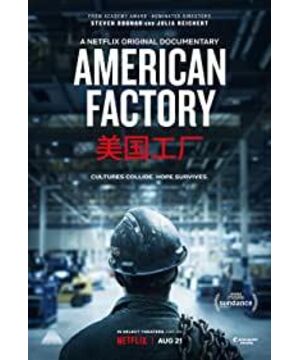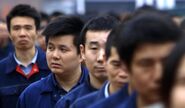(Originally published in "The Surging·Thought Market", with abridged text)
Zhang Ling
In the fall of 2016, I joined the State University of New York and, like all new colleagues, became a member of UUP (Union Union of University Workers). Founded in 1973, UUP now represents more than 40,000 people and is the largest higher education union in the United States. UUP strives for the rights and interests of employees in the State University of New York system, such as better welfare. One of the current goals is to strive for more fair treatment for part-time teachers and obtain support from colleagues. I paid my membership fee ignorantly and kept my membership card carefully. I didn’t have any personal knowledge of today’s treatment as a result of the union members’ struggle for decades. Reichert and her husband Steven Bognar (Steven Bognar) documentary "American Factory" (American Factory, 2019), and read a little information about the history of American labor unions.
"America Factory" about China's "Glass King" and billionaire Cao Dewang opened a "Fuyao" glass factory in Moraine, a Midwestern Ohio area, to manufacture automotive glass in 2014, and hired More than 2,000 local employees (many of them are workers from the previously closed "General" auto factory). During this period, the labor-management relationship turned from excitement and optimism to contradictory conflicts. Not only did the Chinese and American ways of thinking, management differences and misunderstandings, but also the struggle between workers and management who tried to organize trade unions. Issues of class, race, country, etc. are entangled with the globalization of capitalism, and the shadow of automation threatens the future of the world's labor class even more. Reichert and Bergner believe that: Chinese capitalists in the rising period encounter American blue-collar workers in the decline period, there will be stories about capitalism, globalization, cultural integration and more. As Bergner said, "The American Factory" is "close to the ground and look at globalization with close-up shots."
one. American factories, world workers
Many viewers were impressed by the passage in "American Factory" where American managers went to the "Fuyao" factory in Fuqing, Fujian to "learn from experience" and how to improve the efficiency of American workers. This is not only a moment of "defamiliarization" through the American perspective, but also a moment of "eye-opening" for Chinese viewers who have never visited similar factories. The factory is militarized, and workers in regular meetings before shifts line up to shout slogans; they work twelve hours a day without stopping, and take one or two days off each month; some people can only go home once a year to see their children. In sharp contrast to the cruelty that these outsiders seem to oppress and squeeze, CCTV’s "Spring Festival Gala" style company’s "annual party" has harmonious, optimistic, and curious singing and dancing performances and warm atmosphere that moved an American guest to tears. , Said "In any case, we are on the same planet and in the same world, even if there are differences, we are one."
The corporate ideology of the Fuqing Factory is a combination of "feudal family" and "nationalism", and it incorporates the cultural heritage of the factory during the socialist period. In this high-ranking family, Cao Dewang is an indisputable male authority, under his management large and small male authority, leading the grassroots workers who are managed as robots. Managers use the rhetoric of socialism and nationalism to encourage (deceive) workers: "Serve the country for the people" and "industriously learn and innovate" to replace and conceal the essence of maximizing the extraction of workers' surplus value in order to maximize the benefits and classify the nature. This set of words (even the main theme of the factory sings "Spring is full of China, Fuyao") is wise in shaping the illusion of "love each other in the family", and it also molds the labor performance of workers as "virtue". It conducts moral kidnapping and measurement: In order to be "loyal" to the extended family, workers must continuously improve themselves, increase productivity, and be reluctant to work overtime or even reluctantly. Therefore, they have "unity" and "cohesion". This is commendable. Huaxia's "craftsman spirit" with "national mission and pride"-to help enterprises succeed is to help the country develop. If workers have any sense of resistance, they will probably be regarded as lazy, selfish and morally bankrupt, rather than as fighting for their entitlements. The annual meeting also commended the "Best Team Award" similar to the "New Long March Assaulter" before the "Reform and Opening Up". The self-contained dormitories, canteens, entertainment venues, and even collective weddings in the style of state-owned factories suggest a "continuation" of collectivism. The appointment of Cao Dewang's brother-in-law as party secretary and labor union chairman also implies a peace between the labor union, party committee and capital. The labor union is responsible for employees' recreational activities and psychological construction/discipline: loving "Fuyao" means loving the party and the country (it is completely different from the meaning of "union" in American factories, which will be mentioned later).
However, under the capitalist system concealed by glamorous socialist rhetoric, the value, nature and interrelationship of "labor", "machine" and "human" are completely different. The working class is no longer the "big brother", mastering the house in the factory, and carrying forward the spirit of ownership to build socialism, but the migrant worker/new worker who represents the advantage of China's "demographic dividend" in the neoliberal global capitalist competition. They are just alienated low-cost labor in the "world factory", earning huge profits for capitalists; the price of "Chinese efficiency/speed" is the deprivation of workers' health, safety, and dignity. But of course, for many workers, the economic gains have improved compared with the poverty-stricken farming era. It's just that they can be hired when they are young, strong, and fashionable. Will the medical and pension problems of old age be thrown away to the society and individuals? It is reminiscent of the privatization of state-owned enterprises around the turn of the century, the old workers who had worked hard for the country for half their lives but were ruthlessly abandoned by capital. Nowadays, even in the high-tech industry, the controversy over "996" is the status quo of the squeeze of Chinese technology workers. The strength of labor unions in the high-tech industry in the United States is declining. Companies such as Google have designed a variety of convenient services for (especially single) employees in the company, from cafeterias to gyms and game rooms, making employees willing to stay in the company for longer (naturally voluntary work overtime for longer) ), not to mention that in the so-called "sharing economy", workers such as online ride-hailing drivers and takeaway workers are no longer regarded as company employees but only contractors, and do not enjoy employee benefits and are protected by labor laws.
The corporate culture of "Fuyao" cannot be relocated to the United States. Under the long-term struggle of labor unions representing the rights and interests of American workers, the eight-hour working day and weekend breaks have been written into the law. Industrial workers have also become more aware of their rights in the long-term struggle. In the eyes of Chinese managers, American workers are slow, lazy, chatting, inefficient, working for wages, and lacking the "sense of mission" and "sense of responsibility" of Chinese workers. Compared with the Chinese workers who worked overtime and worked hard and complained (they came here for a year or two, still earning a few thousand yuan monthly salary in China, but an extra 50 dollars in food and beverage subsidies per day), the once-proud American workers fell short and even felt disillusioned. Obviously, not only for "Fuyao", but also for the way their country treats them, and the future of the American working class, and even affect the results of the 2016 U.S. election: Ohio is located in a declining industrial zone (the so-called rust belt), Originally a swing state, this time became Trump's ticket warehouse-some workers believed that Hillary Clinton represented the interests of high-tech upstarts in the California Bay Area and was out of touch with the bottom of the manufacturing industry, and was deceived by Trump's slogan of "Make America Great Again". This slogan was also used by Liu Daochuan, the Chinese president later replaced by Cao Dewang, to encourage American workers to increase their productivity. Reichert and Bergner discarded all the footage taken before and after the 2016 elections, fearing that they might be overwhelming and creating divisions.
Of course, the cultural differences between Fuyao's management and American workers cannot be ignored. Americans do grow up in an environment full of praise and encouragement, and they care more about whether they are respected (even if it is appearance). Chinese supervisors must maintain their authority and hierarchy, focusing on criticism. American workers think they are not respected, because the Chinese never say: Well done! However, the appearance of cultural and ethnic collisions obscures the interests of classes that transcend countries, and the issue of neoliberal capitalism has been shifted to issues of race and xenophobia (such as Trump’s repeated emphasis on "the Chinese have stolen our jobs"), or Cao Dewang attributed the dissatisfaction of American workers to: "American workers are hostile to the Chinese." This reminds me of the documentary "Who Killed Vincent Chin" (Who Killed Vincent Chin, 1987) by Chinese female director Cui Minghui. In 1982, Chinese youth Chen Guoren was beaten to death with a baseball bat by two white men from the "Chrysler" car factory in Detroit because they thought he was a Japanese. At that time, the Japanese car became a strong opponent in the American market, which made Detroit's automobile industry. At stake, many American workers are unemployed and hate Japanese (and even Asians). In addition to the deep-rooted white supremacy racism in the United States, this is also a tragedy in which the most basic-level workers, who are also victims, are killing each other under the brutal competition of capitalism. In fact, both Chinese and Americans at all levels (including lawyers and managers) employed by "Fuyao" have become agents of exploiters due to profit-driven (income several times, ten times or even dozens of times the wages of workers) People and thugs. Soon after the beginning of "American Factory", Vice President Dave heard a congressman mentioning that "Fuyao" should have a union in the celebration speech, and he wanted to "cut off his head."
American workers lamented: The old days of high wages and high benefits are gone forever-they can't help but accept the reality that in the past, the hourly wage at the "GM" factory was 29 US dollars, and the "Fuyao" was less than 13 US dollars. On the other hand, the Chinese migrant workers/new workers in the “world factory” have never even experienced the “luxury” of welfare and dignity, not only because of the time difference of late capitalism, but also because of the expansion of capitalism’s globalization. Workers in the "Third World" will always be at the bottom. Although workers in European and American countries are both exploited in globalization, compared with the latter's treatment, they are "cheaper labor" and are less protected by labor laws. When the Chinese government gradually improved its labor laws, the profit-seeking nature of freely flowing capital caused factories to move to areas with cheaper labor and fewer labor laws, such as Southeast Asian countries.
When filming "American Factory", Reichert and Bergner entered with affection for American workers, and gradually discovered that Chinese workers are also worthy of attention. This is the common destiny of the labor community in globalization. However, because they did not understand Chinese, they could not communicate with the two hundred Chinese workers of "Fuyao". After shooting for a year, they realized this important deficiency, so they found two Chinese filmmakers, documentary director Zhang Yiqian and Li Mijie. They go to Ohio to film every month and also go to Fuqing to build trust and contact with the Chinese in the film. The director and his wife believed that they helped directors understand China's corporate culture, customs, ways of thinking, and history, and taught them to look at the lives and emotional states of ordinary Chinese workers. This film does not have the stereotyped expressions of many Western directors who were preconceived when filming in China. They have a gentle and humble attitude. The only regret is the lack of perspective of the Chinese female workers.
two. American factory, American union
Ohio African American Democratic Congressman Fred Strahorn pointed out: The workers and the labor movement built America. The rights and interests of American workers are the result of the bloody and sacrificed struggles of countless predecessors who participated in the trade unions, not the extra benevolence of consortia and capitalists. The “U.S. Auto Workers’ Union” (UAW) that appeared in “American Factory” is the largest independent trade union in the United States. , GM, Ford) recognized its legal status in negotiating on behalf of workers. The basic purpose of the trade union is to safeguard the basic rights and interests of workers, protect workers' right to speak, and find a balance between corporate profits and employees' rights and interests. UAW strives for higher wages and better benefits for workers, and supports their "American Dream" of stability and prosperity. At its peak (1979), it had more than 1.5 million members. Now it is affected by the transfer of the automobile industry abroad and various anti-union measures by the consortium. Reduced to more than 300,000 people. Although UAW later had bureaucratization and corruption problems, its history and positive significance in fighting for labor rights should not be denied. With various right-wing media and politicians constantly vilifying, discrediting, and generalizing propaganda, labor unions seem to have become the culprit in the decline of American manufacturing, without mentioning neoliberal economic policies, globalization, capital transfer, and deindustrialization. .
The labor movement and trade union organizations in the United States flourished mainly on the east and west sides and the Midwest. In the southern United States, it is much more difficult to organize labor unions. It is also related to political conservativeness and segregation. Therefore, the German and Japanese automobile companies that later invested in the United States chose to invest in the southern part of the country where the labor law protection is weak. These factories, with the obstruction of various parties, the trade unions have not been able to organize so far. The employer lowers the wages of workers, that is, reduces labor costs, and guarantees the price advantage of Japanese cars in free market competition. These "benefits" to the management are unmatched by American auto factories with a long history and strong union strength, so they shut down factories in the United States and instead squeezed cheaper Mexican workers.
"American Factory" does not explain the history and current situation of labor unions in the United States. It may be regarded as common sense for American audiences, but it delicately reveals how "Fuyao" spent a huge sum of money ($1 million) to hire an anti-union consulting firm (LRI). /labor relations institute) in the training in which workers are forced to participate, distorts the union as a barrier between workers and management rather than as a spokesperson for their rights and interests, and asserts that the results of the union may be more detrimental to workers’ wages and benefits. At the other end of the "two-pronged approach", the management raises salaries to buy some workers and finds excuses to expel activists who organize unions, thereby dividing workers' strength and weakening the voice of joining the union. Many workers have been "trained" and feared and voted against them, especially young people who have no experience in union struggles and are worried about losing their jobs. Of course, if the union organizes workers to strike, they will no longer scare employers (a loophole in the labor law allows employers to fire strikers and hire other workers at any time), and they no longer have a bargaining chip. Under the strong pressure of capital, Jill, a middle-aged female forklift worker with a sense of justice, finally found a job and moved out of her sister's basement to live in an apartment she rented. She was expelled for participating in the trade union movement and had no means of living. In sharp contrast, private companies like LRI that destroy unions are hot and become a huge and profitable industry. They contribute to the corporate culture of declining guild members and declining wages for workers.
Cao Dewang, a savvy capitalist, once calculated that, in addition to labor costs, the costs of investing and setting up factories in Morion are lower than those in China (it can be seen that domestic factories rely heavily on exploiting workers to reduce costs and profit), and the governments of various parts of the United States Competing for investment projects and continuously introducing huge preferential subsidy policies. "Fuyao" employs more than 2,000 local workers, and the city and state governments provide various subsidies, making it free of charge to buy land and renovate factories. Get rid of the confidant trouble of the "union", and replace him with young workers with better agility and physical strength and the threat of automation to workers. He no longer has to worry about American workers "creating trouble."
The closing subtitle of "American Factory" reads: By 2030, automation will require 375 million people around the world to find new types of jobs. The picture shows Chinese and American workers rushing to and from get off work. I remembered that Chaplin’s film "Modern Times" (1936) opened with a montage method to cut the flock of sheep and the bustling industrial workers together, implying the same fate of being slaughtered. The last shot of "American Factory" is the blurred back of the workers, a bleak and unknown future. Reichert said that the ending of "American Factory" is disturbing. It is not the kind of movie where people will stand and cheer after watching. The world's proletarians have no possibility of uniting for a long time, but capital and capitalists have spread their wings of "globalization" and flow smoothly in pursuit of profit. Some people say: Capital turns humans into machines and abandons humans when the machines mature.
three. American factory, American director
Dayton, where the "Fuyao" factory is located, has a history of innovative inventions and industrial manufacturing that locals are proud of. It is almost two generations ago in the "Silicon Valley": this is where the Wright brothers invented the airplane and the cash register was born. Here. The factory of General Motors (GM), one of the three giants of American auto manufacturing, has been open for 86 years here. The “GM” factory is very important to the local area. From the 1950s to the 1980s, through the struggle and protection of labor unions, blue-collar workers without higher education can get good income and benefits, and they can have a house, a car, and give away their children. In the middle-class life in college, different ethnic groups coexist peacefully. After the 1970s and 1980s, European and Japanese cars, which consume less fuel and have lower labor costs, increased their market share in the U.S., and the U.S. auto industry was hit. In order to reduce costs, American auto factories have been relocated to Mexico, and the Dayton community has gone from bad to worse. In 2008, the "GM" production line was closed after driving the last truck, leaving thousands of unemployed workers and their desperate families.
In those difficult days, directors Reichert and Bergner went to the factory entrance and nearby bars to film and interview every day-they lived in Dayton for decades, and their residence was only a 20-minute drive from the factory. Because American auto factory workers are always discredited by anti-union commercial media, they are wary of people holding cameras. The director won the trust of the workers with his sincerity and persistence. He shot a 40-minute documentary " The Last Truck: Closing of a GM Plant " ( The Last Truck: Closing of a GM Plant , 2009, produced by HBO). The film was nominated for the best documentary Oscar that year. Regrettably, "The Last Truck" only has a worker's perspective, because "General" management and decision-makers refused to be interviewed and the director was forbidden to enter the factory for filming, and security guards were sent to stop and drive them near the entrance of the factory. The footage of the factory floor was secretly filmed by workers using mobile phones or small high-definition cameras provided by Reichert, and part of them appeared at the beginning of "American Factory."
"American Factory" is a bit like the "sequel" of "The Last Truck", because a few years later, "Fuyao" bought the "GM" abandoned factory and moved in with a high profile under the warm welcome of the local government and people. Reichert and Bergner believe that: Chinese capitalists in the rising period encounter American blue-collar workers in the decline period, there will be stories about capitalism, globalization, cultural integration and more. Local business people like "The Last Truck" and suggested to Cao Dewang that the Reicherts film this historic moment. Cao Dewang agreed without any restrictions, leaving the Reicherts team with five people and five cameras to shoot for three years (February 2015 to December 2017). In those difficult moments when the labor union disputes heated up, and when Cao Dewang was prone to criticism (such as expelling American managers, etc.), he did his own thing and never interfered with the filming.
In order to maintain its independence, "American Factory" was not funded by the "Fuyao" group. The producer was Participant Media-the company also produced the Mexican director Alfonso Cuarón's film "Rome" (2018) and African Americans Female director Ava Djolie’s drama "Colored Glasses" (When They See US). "American Factory" won the Best Director Award for American Documentary Film at the Sundance Film Festival, and went live on Netflix on August 21. In China, where Netflix is not covered, there are also widespread dissemination and lively discussions. Many media claimed that former US President Obama and his wife "invested in the production" of the film, and even hinted that it was "Obama's film", which is very inaccurate. The Obamas did plan to set up the production company "Higher Ground" and cooperate with Netflix (for the "celebrity platform" effect, the latter will have to pay the former tens of millions of dollars), and "American Factory" is the first film that "High Ground" chose to release. Movies, and the copyright is purchased at a lower price (Netflix does not allow public acquisition prices), but "Highland" does not participate in the production of the film to any extent, only post-release. Ironically, despite being regarded as a labor-friendly president, during Obama’s presidency in 2009, he did not make any effort to promote the "Employee Free Choice Act", which would make it easier for workers to organize trade unions and increase protection against violations of labor laws. Employer’s fine. Some people think he abandoned the labor movement. Ten years later, he high-profile support for the "American Factory" involving labor rights, avoiding the most important issues, and constantly emphasizing "tell a good story, let us improve understanding" and other spiritual chicken soup.
Although almost obscured by the aura of the Obamas, Reichert and Bergner are not unknown, especially the former, who are important figures in American documentary history. If you talk about heroes in terms of awards, three of her works have been nominated for Oscars for Best Documentary Film, and I also won the Lifetime Achievement Award from the International Documentary Association in 2018. In May of this year, the Museum of Modern Art (MoMA) in New York held a retrospective of her work. Reichert is a retired professor at Wright State University in Dayton, where he taught documentary production for 28 years. She has always been a conscientious documentary worker, and she has been concerned about gender equality and social justice. She has several important works such as "Growing Up Female" (1970), "Union Maids" (1976), "Seeing Red" (Seeing Red, 1983) is often observed and discussed in documentary history and gender studies courses in the United States.
Reichert is a baby boomer in the United States after the war. Most of the people of that generation have been baptized by the anti-Vietnam war, race and gender equality movement. They have progressive ideological tendencies and emphasize action, and they have relentless pursuit of social justice and labor rights. Reichert said that he started the documentary creation as a woman, to break the masculine structure of the image expression, and spread his ideas to a wider range of people in such a more people-friendly form, so as to stimulate thinking and discussion, and then put it into action. Change society. "Growing Women", a collaboration with his partner Jim Klein at the time, is Reichert’s graduation work. It is about the stories of several women in a certain town in Ohio, and discusses how women are disciplined by the education system, popular culture, and social expectations. , Shaped gender recognition and inferior social status, now it seems that the current disadvantages are still pointed out. This is an important work of the feminist movement in the United States. It has been shown in various parts of the United States for many years, in an intuitive way to enhance the viewer's awareness of reflection and explain to skeptical people what gender equality is. In 1971, Reichert founded New Days Films, a distribution company in the form of a "co-op", which avoided the commercial operation of movie theaters and directly screened in schools, labor unions, and community organizations. It was a non-profit public education model.
Reichert and Klein’s "Union Maid" was nominated for Best Documentary Oscar. It is an oral historical documentary interviewing three women who experienced the labor movement in the 1930s in the United States. The struggle for paid jobs does not shy away from discussing the bureaucratization and racial and gender discrimination within the unions led by white men. The two people's collaboration "Viewing "Red"" won another Oscar nomination for best documentary. This film re-excavates the obliterated history of the American Communists: between the "Great Depression" (late 1920s) and the beginning of the "Cold War" (late 1940s) in the United States, more than one million Americans joined the Communist Party of the United States with passion. Fighting against hope, for the rights and dignity of the working class, and for a more just and equal world, I believe this is the right direction for the future of the United States. As the "McCarthyism" persecuted progressives in the United States and the "anti-communist" atmosphere became more and more tense, people remained silent and kept silent about this period of history. This fear was still in the 1980s when the director was filming.
Compared with Reichert’s previous documentaries, "American Factory" is less crude and simple, more familiar, and closer to mainstream documentaries. Part of it lies in the original soundtrack and the director’s first hire of editors (most of the previous works were edited or edited by themselves). Klein help)-Lindsay Utz spent 18 months cutting 1,200 hours of material to 110 minutes. The director and the editor discussed for a week and put up index cards on the wall to mark different characters and main lines. However, due to the huge subject matter, too many clues and characters, it is impossible to go deep one by one. In addition, people rarely talk about the sound of a documentary, and the director of this film pays much attention to sound recording. They use small microphones to increase the sense of privacy and try to eliminate noise interference in the factory workshop when the characters are speaking. In some interviews, only the voice is recorded and used as a narration to complement the scenes of the characters doing other things, such as the audience listening to their thoughts or inner monologues. Because the work on the production line is boring and repetitive, people's thoughts are easy to wander. Directors sometimes follow the off-duty workers to their living spaces to listen to their daily conversations. Some interviews were recorded at the workers' homes at two o'clock in the morning, and Bergner believes that people's inner thoughts and soul thoughts can be heard even more at this time.
The other is a metaphorical "voice", which speaks for the bottom layer. After "American Factory" was screened at the Museum of Modern Art in New York, a man stood up and said, "I am Michael Moore. All of your films have an important influence on me, especially when we all grew up in labor families in the Midwest. We can’t see ourselves in the movie and our voices are ignored. Thank you for speaking up for us.” Moore’s documentary "Roger and Me" (Roger and Me, 1989) records his hometown, Flint, Michigan, as the "Motor City" The decline of ""-as experienced by Morion residents, tens of thousands of local people were unemployed due to the shutdown of "GM", and people's livelihood was difficult. Despite their different styles of work, Reichert also admires Moore and believes that he has expanded the form of documentary, such as a punk rock kid breaking into a well-dressed party, laughing and cursing to expose all kinds of hypocritical systems. Reichert also follows in the footsteps of documentaries that have had a deep impact on her (mostly masterpieces on American civil rights and the union movement), such as "The Times of Harvey Milk" (The Times of Harvey Milk, Rob Epstein, 1984), "Unwavering: The American Civil Rights Movement 1954-1985" (Eyes on the Prize, 1987), Barbara Kopple's "Harlan County, USA, 1976" and "The American Dream" "(American Dream, 1990)-Both are about American workers' strikes under the leadership of labor unions. The former wins and the latter fails. The weakening of workers and the rise and fall of labor unions reflect the economic changes and the trend of capitalism in the United States from the 1970s to the 1990s. . Another German documentary, Losers and Winners (2006, Ulrike Franke and Michael Loeken), which she did not mention, is about a situation similar to "American Factory": Chinese workers in the Ruhr Industrial Zone in Germany Encountered the differences and conflicts of German workers.
As a director who has always been concerned about social issues, Reichert rarely takes the individual as the protagonist of the documentary. She focuses on the community, especially the deprived and marginalized labor group. She mostly adopts the form of "direct film" and interviews, without intervention by narration, and the message is explained by subtitles. Therefore, the director’s perspective is mostly constructed through interviews and editing: the juxtaposition, contrast, debate, and dialogue of different perspectives. "American Factory" lacks the rough edges and sharp edges and clear political appeals of Reichert's previous works, and appears to be quite stable. Because the director wants to balance the voices of all parties (even if those perspectives conflict with each other), he does not "stand in line" politically, and has a certain degree of sympathy and understanding for each party, including Cao Dewang. Reichert later said in an interview: Cao Dewang is a Buddhist and an out-and-out capitalist who wants to make a profit and constantly forces others to achieve his goals. He missed the past of the pastoral period, which was once again the waver of the capitalist wave. This person is also very complicated. They try to express this complexity.
Reichert also understands the despair of American workers, because the gap between the rich and the poor is unprecedented: people have never seen an era where CEO wages are 500 times that of ordinary workers. Reichert and Bergner believe that in this increasingly torn political environment, they want everyone (boss, managers or blue-collar workers) to watch this documentary and discuss relevant socio-political issues, such as why workers’ wages are stagnating. The income of the wealthy class has not changed and the income of the rich has increased year after year? How to create a future that belongs to everyone? What kind of economic and cultural structural changes brought about by globalization, and what impact will it have on the lives of ordinary people? Bergner said: Dialogue with each other is more meaningful, rather than hiding in your own corners and slogans. Reichert believes that in our public discussions, there is less and less understanding and support for the disadvantaged, even in our daily lives. She hopes to use documentaries to educate and unite the people instead of dividing them.
View more about American Factory reviews








